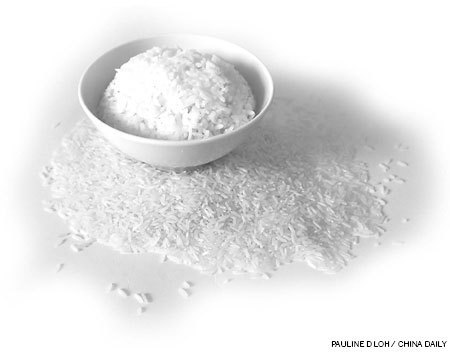Chitosan in rice - what's that?

In the media fuss over food-safety issues, one intense debate rages on. Do we or do we not need preservatives in rice? Pauline D Loh tries to unravel the what, why and what next.
Chitosan. The first time I saw that word was on a bottle of supplements supposed to help my ageing, aching joints. Now, it's on the list of permitted preservatives for rice, a coating that is supposed to help prevent mildew and retain the freshness of the grains. The other is sodium diacetate, also used to keep rice from rotting.
I know from my limited knowledge that chitosan is something they get from chitin, which is what crustacean shells are made of. Vegetarians take note. Your next bowl of rice may be seafood-flavored without you even knowing it. That's one more reason to read the labels very carefully at the supermarkets, if the rice manufacturers even bother to tell you.
According to the experts, chitosan is harmless, and has been widely used in horticulture and agriculture - most often as an eco-friendly biopesticide that protects plants against fungal infections and promotes healthy seed growth. If it's any consolation, the United States Department of Agriculture approves but regulates the use of chitosan on organic certified farms.
But the question on everyone's mind is: Why do you need preservatives in rice? It is a cereal that keeps exceedingly well on its own, and is famously rot resistant. Traditionally, all it needs is to be vacuum-packed or be packaged in nitrogen-aerated bags for a longer shelf life.
Perhaps the clues to the mystery can be found in history. We can also take into consideration the vastness of China - in both its land and its population.
Within relatively recent memory, the deep dark shadows of hunger had threatened when China went through a period of severe food shortage. Rationed flour, oil, rice and precious food coupons were all part of life then.
It is little wonder that the current administrators, probably among those who remember those hard times well, have been making certain that something like that would never happen again in the country.
China now has enough reserves stored to last several years should drought or disaster reduce the supply of grains and cereals. Like the Biblical seven fat years and seven lean years, the grain silos are on the ready.
It goes without saying that stored grain must be kept fresh and mildew-free, or all the effort will go to waste. Not all silos are technically up-to-date, and some in the less developed regions may be nothing more than barnyard space subject to the destructive elements of wind, water or sun.
While it is understandable for the authorities to want to preserve all the hard work that goes into the harvest, perhaps there are safer, more natural ways. In most rice producing countries, and indeed the usual practice in China now, rice is kept from degrading in vacuum packs or treated with nitrogen, with no other additives.
But let's risk common wrath by playing devil's advocate.
China's food industry is suffering from an onslaught of food safety issues stemming from the unethical practises of a few and we will not go into details here.
In the knee-jerk responses to the issue of adding preservatives to rice, it seems most people have overlooked one crucial point.
There had been a consultative process, which was largely ignored.
Officials had "sought opinions from July to September last year" and having elicited no response, the two permissible additives to rice were passed by default.
In the face of such severe reaction, health officials are saying that if anyone in the industry raises objections, the standards can be changed "at any time".
The onus is now on the industry itself. Someone must come out and clarify why and if there is a need to use preservatives on rice. After all, part of after-sales work is good public relations and consumer education.
Will the rice industry take steps to ensure that rice in China stays above comparisons to tainted milk, pigs on steroids or imitation Peking duck? We wait with bated breath.


















